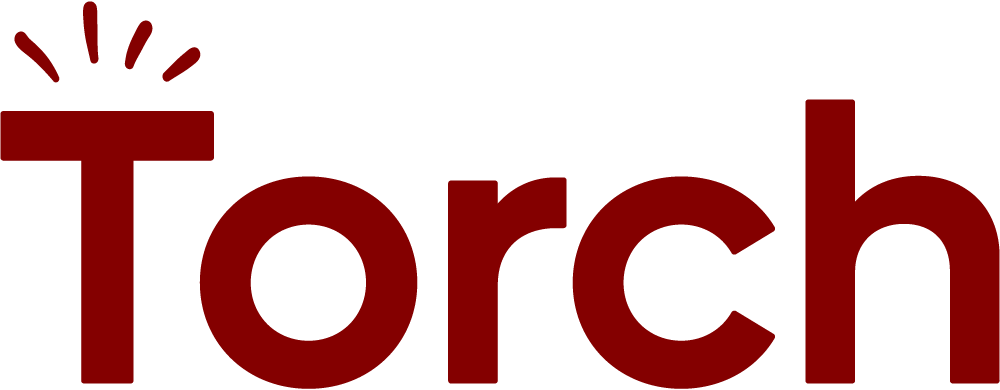We often speak with organizations who have invested hundreds of thousands of dollars in digital course offerings and workshops for their employees. But when the Learning & Development (L&D) leader assesses whether the programs actually helped their business, they are unable to find clear proof of the programs’ impact. These stories are far from unique; countless other businesses face the exact same challenge — they invest significant resources into their programs, only for nothing to change in the long-run.
For L&D programs to create real, measurable benefits like higher performance, team satisfaction, and retention, HR leaders need to shift away from providing short-term, one-size-fits-all solutions. Instead, programs should focus on equipping individuals with the tools necessary for changing their behavior in a sustainable way.
But what does it take to really change someone’s behavior long-term? At Torch, we partner with hundreds of leading organizations, helping HR leaders integrate 1:1 coaching into both new and existing programs. Specifically, we’ve found that four elements ensure these L&D programs create real and lasting behavior change:
1. Build momentum from the start
While we know that coaching leads to behavior change, it’s not enough to just have a coach. In order to reap the benefits of coaching, and capture lasting behavior change, participants need to be actively engaged with their coach. Engagement is heavily influenced by a participant’s first impressions of and interactions with the coaching program and platform. Based on our data, we know that sustainable behavior change is much more likely if participants are engaged – for example, logging into the platform frequently, booking regular sessions with their coaches, etc. – in the early stages of their coaching journey.
At Torch, we’ve optimized our onboarding experience to maximize participant engagement from the start. When participants log in to Torch, they arrive at a streamlined homepage that allows them to easily find information about their coaching engagement, identify and complete key action items, and access resources that walk them through how to make the most out of their coaching engagement, so they can hit the ground running.

View of participants’ homepage experience when they log into Torch
2. Make sure your people are moving in the right direction
“It’s helpful to have a coach who is dedicated to your specific goals and actually getting into the nitty-gritty and working with you to really understand the full context of the situation before trying to apply a solution.” – Vince Ning, Co-Founder and Co- CEO at Nabis
While coaches are experts at helping participants grow and develop new habits, they rely on participants to provide them with important context. Here are a few examples of context a participant brings to the engagement:
- – information about organizational goals
- – a self-assessment of their key focus areas
- – the goals and challenges of their specific team
Being able to bring these to their coach requires that a participant has high levels of self-awareness, as well as full context and alignment with their manager.
With Torch’s Manager Alignment Meetings, participants can invite their manager to a joint meeting with their coach. This enables coaches to gain more context around the team’s goals and challenges and helps them better understand the participant’s unique growth opportunities. On top of that, this feature allows participants to set growth expectations with their manager, right from the start, empowering managers to support the participant and hold them accountable through their growth journey.
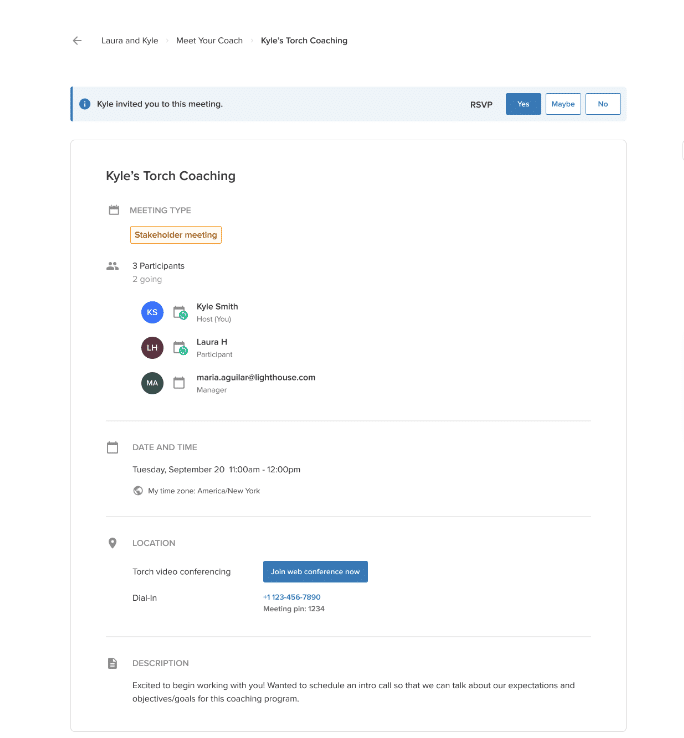
Torch’s meeting scheduler allows participants to invite their manager to a joint coaching session
In addition, Torch structures every coaching program around your organization’s unique leadership competencies. Employees will see customizable organizational guidance right on their dashboards, and as they progress, they’ll also be able to tie peer feedback and goals to the priorities dictated by the organization. This way, your employees can focus on the areas that matter most to your organization, without risk of misalignment.
3. Make growth a team effort
Without clear guidance, data, or validation, the concept of ‘growth’ can feel vague and directionless. That’s why Torch coaching sessions occur alongside other resources that help the participant and coach direct their growth – for example, a 360 leadership assessment rooted in behavioral science that collects feedback from their peers, direct reports, and managers, to point them in the right direction.
Torch also has a new peer feedback tool to provide participants with insights around their growth, including areas where they’ve improved in and where they can continue to grow. This new feature enables participants to request direct feedback from close colleagues, managers, or direct reports over the course of their coaching engagement. This allows each participant to understand whether their new behaviors are having a positive impact on those around them. The feedback is then summarized into a report that participants and their coach can use to identify additional areas of growth and opportunity.
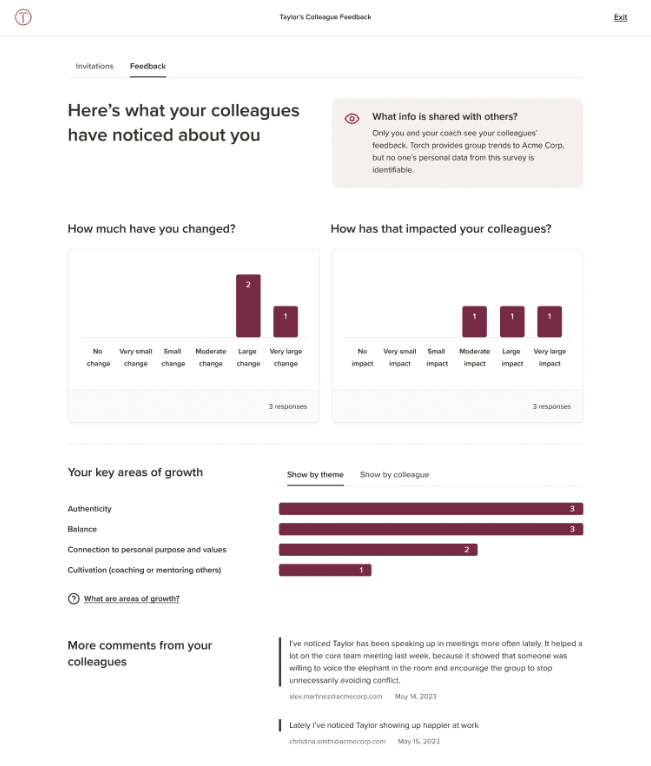
Participants can access aggregated reports of feedback their peers leave for them
4. Measure the impact of your investment
“With help from Torch’s data science and analytics team, Reddit has been able to deeply understand the impact that Torch coaching is having on our employees throughout their careers.” – Tramel Dodd, Director of Learning and Development at Reddit
There are many ways to measure coaching’s impact on an organization. At Torch, we leverage the Kirkpatrick model to look at behavior change. The Kirkpatrick model separates impact into four tiers – reaction, learning, behavior, and results – and each tier requires different data and reports to accurately measure success. To help you fully understand the impact of your investment, Torch has new features that equip you with the data necessary for measuring and reporting the impact of your coaching program at each level.
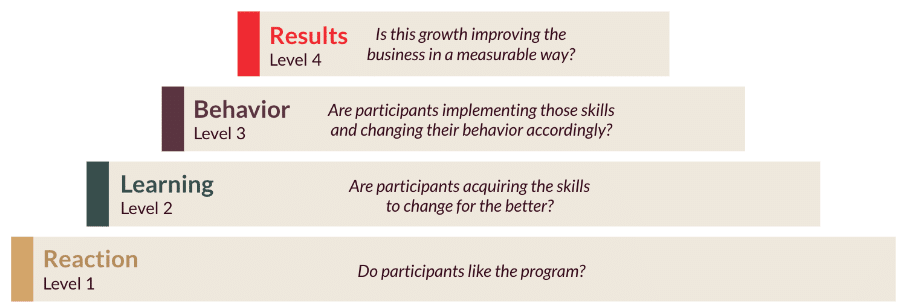
Levels of the Kirkpatrick Model
At the reaction level, the Kirkpatrick model tells us that behavior change isn’t possible if participants aren’t engaged in their coaching program. Torch provides detailed reporting capabilities that give program admins access to real-time, actionable data on participant engagement, so they can always be in the loop around overall program health.
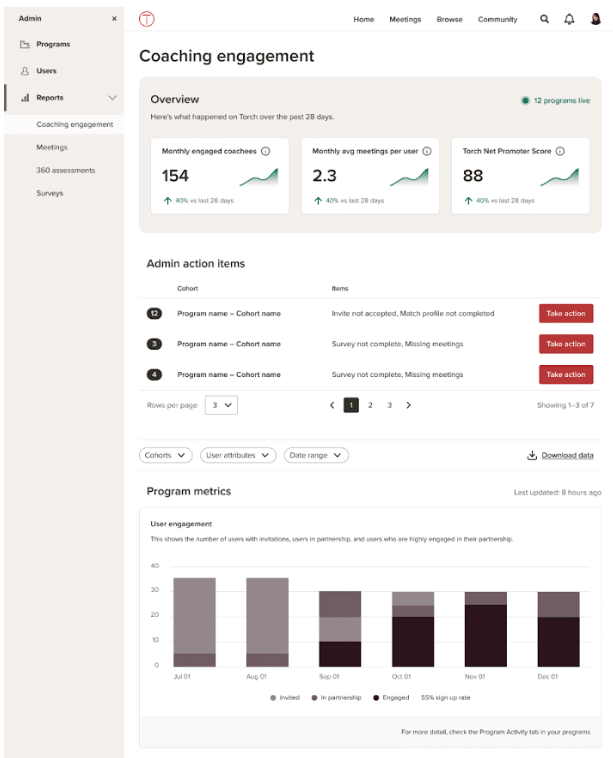
Admins can view program insights and data in Torch’s coaching engagement reports
With program health accounted for, your second core measurement should be behavior change. To help admins measure behavior change, Torch provides valuable feedback from participants’ managers, peers, and teams that admins can leverage in the form of reports and insights.
With tools that enable sustainable behavior change, organizational alignment, peer feedback, and measurable outcomes, Torch creates an environment that supports upskilling and creates lasting behavior change in employees. Learn more about how you can create lasting behavior change in your employees by scheduling a personalized walk-through of Torch today.
